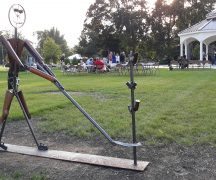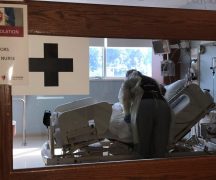In the face of spiking gun crime, the state’s top two officials on Thursday announced a $10.5 million investment in technology and personnel to trace fugitive guns across jurisdictions.
As he announced the program, Gov. Mike DeWine denied that when he signed a bill earlier this month eliminating gun-permitting requirements, he might have helped to make the problem of gun violence worse.
DeWine gathered with Attorney General Dave Yost and top state and local police brass at Bureau of Criminal Investigation Headquarters in London to announce enhancements to the state’s participation in the National Integrated Ballistic Information Network, or NIBIN.
The network uploads information about used shell casings into its database, allowing police elsewhere to see if they match casings collected from crime scenes in their jurisdiction. Individual guns make unique marks on shell casings, so comparisons of those marks can identify guns used in multiple crimes.
The system “doesn’t solve crimes, it generates leads,” Yost said.
Those leads are sorely needed in Ohio right now.
The pandemic year of 2020 saw a 26% jump in reported gun crime, DeWine said, adding that 1,000 Ohioans have been injured and 650 killed in gun crimes over the past 18 months.
The number of gun deaths in the Buckeye State has jumped 47% over the past decade, to 1,789 last year, according to Ohio Department of Health data reported earlier this month by the Capital Journal.
The technology that Ohio leaders want to use to help solve gun crimes isn’t new. There currently are six machines in the state that can analyze shell casings and upload those analyses to the NIBIN database.
Last October, a trucker on the Ohio Turnpike pulled over to check his load when he spotted a gun on the roadside and reported it, said Col. Richard S. Fambro, superintendent of the State Highway Patrol. Police fired the gun, analyzed the casing in a machine in Toledo and uploaded the analysis to the NIBIN database.
In January, analysis indicated that “the weapon was actually used in a homicide in Akron,” Fabro said. “That gun was subsequently released to a detective from the Akron Police Department who had an ongoing investigation.”
As the example illustrates, the technology might not solve gun crimes but it can provide valuable leads and produce potential evidence. The problem, Yost and DeWine said, is the database has too many holes.
To fill them, the money announced Thursday will purchase seven more NIBIN machines to be placed across the state, add personnel to run them and make it free for local agencies to have guns and shells analyzed.
The more complete the database, the more valuable of a crime-fighting tool it becomes as police across the state become more likely to find matches elsewhere to guns and casings used in crimes in their jurisdictions. In that sense, the database functions similarly to fingerprint and DNA databases, Yost said.
But for the governor, the desire to solve gun crimes might stand at odds with a law he signed on March 14 that arguably will create more of them. In June, all Ohioans 21 and older who are legally allowed to have guns will be able to carry concealed weapons without permits or training.
There is reason to believe that the law will produce more gun deaths in a country where in 2018, they eclipsed motor-vehicle crashes as the single largest cause of traumatic death.
Rates of gun deaths vary widely by state, and some studies have shown that those whose laws provide easier access to guns have more gun deaths — including suicides, which account for most firearm deaths.
The causes of gun homicides are less straightforward, but the American Public Health Association in 2017 correlated states with looser gun laws with higher handgun homicides.
DeWine was asked whether, by signing Ohio’s permitless-carry law, he was, in effect, paving the way for more gun crimes to be solved.
Without saying so directly, DeWine seemed to deny that easier access to guns could lead to more homicides.
“Criminals are the people you need to worry about,” he said, alluding to a study he had done when he was attorney general. It concluded that in Ohio since 1974, most violent crimes were committed by repeat offenders, he said.
“The reality is if someone before that (permitless carry) bill was signed, if a criminal wants to have a gun on them, they’re going to have a gun on them,” DeWine said. “The problem is people. The problem is the criminals. You have to go after the violent offenders and lock them up and keep them locked up.”
***
Also from Ohio Capital Journal:





